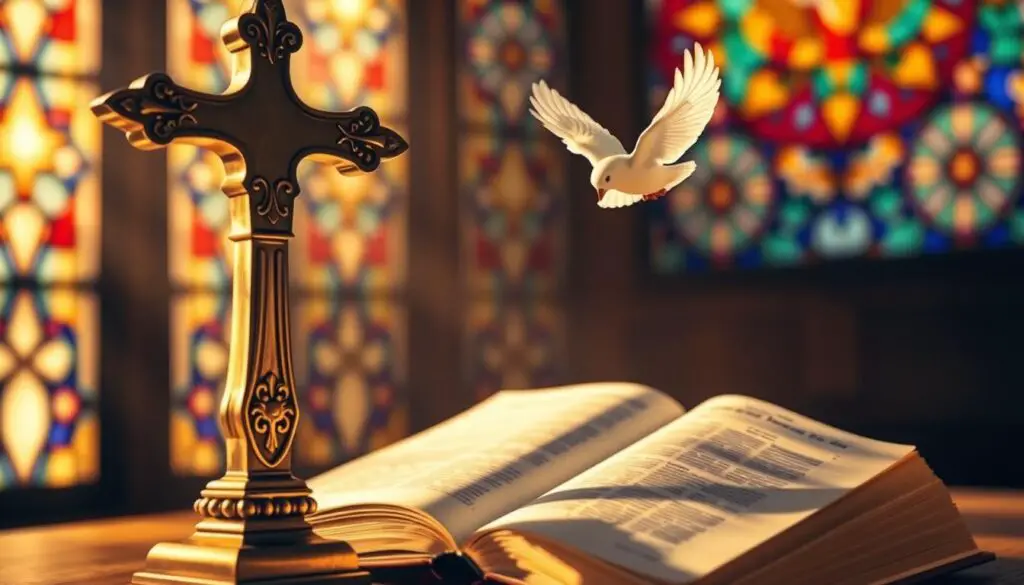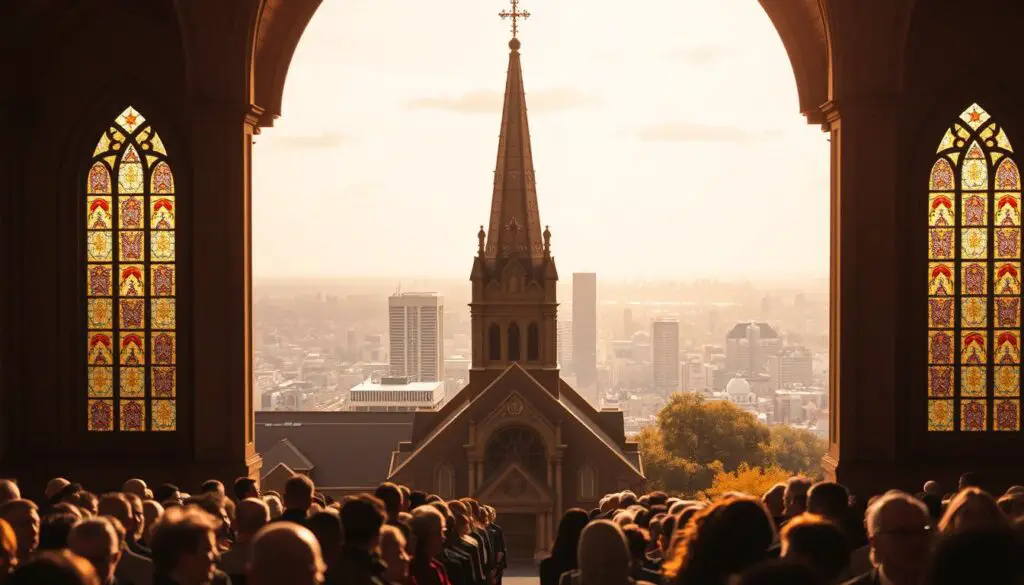Step into a faith tradition rooted in historical resilience and modern-day compassion. For over three centuries, this denomination has championed spiritual autonomy and community uplift, blending timeless values with evolving societal needs.
Originating from early General Baptist teachings, the movement grew through collaboration with Puritan dissenters. Leaders like Benjamin Randall and Paul Palmer shaped its identity, emphasizing personal choice in salvation and scriptural authority. Their efforts laid groundwork for religious freedom across America.
Today, congregations prioritize service through food banks, youth programs, and disaster relief. This hands-on approach reflects core beliefs: every individual holds inherent worth, and collective action creates lasting change.
Key Takeaways
- Founded on 18th-century principles of spiritual freedom and biblical truth
- Pioneered religious liberty concepts during America’s formative years
- Maintains active outreach through local congregations nationwide
- Blends historical theology with contemporary community service
- Recognized for structured denominational cooperation since 1935
Overview of Free Will Baptist Church History & Origins
The roots of this faith community stretch back to 17th-century England, where early dissenters championed personal spiritual choice. These reformers, later known as General Baptists, emphasized scripture over hierarchy—a radical idea that crossed oceans with colonists seeking religious freedom.
Early Beginnings and the Influence of General Baptists
By the 1700s, these ideas took firm root in colonial America. Leaders emerged who valued both individual conscience and collective worship. Their approach laid groundwork for structured religious organizations while maintaining local autonomy—a balance that still defines many congregations today.
Palmer and Randall Movements in American History
Paul Palmer planted early seeds in North Carolina between 1702 and 1727, establishing communities that prioritized accessible theology. His work created a blueprint for expansion, proving that grassroots efforts could thrive even without centralized control.
Further north, Benjamin Randall sparked a parallel movement in New England. His teachings attracted diverse followers by blending traditional beliefs with practical community support. This era saw the first formal associations, marking a shift toward organized collaboration among independent groups.
Historical challenges like debates over slavery tested these networks, revealing both strengths and fractures. Some groups merged with larger denominations, while others maintained distinct identities. These decisions shaped the faith’s trajectory, demonstrating how adaptability preserved core values through changing times.
Foundations in Theology and Beliefs
Central to this denomination’s identity are principles that shape spiritual journeys and daily practices. Its teachings balance divine grace with human responsibility, creating a framework for meaningful faith experiences.

Core Doctrines: Free Salvation, Free Will, and Conditional Security
Believers emphasize free salvation—a gift available to all through Christ. Unlike groups teaching eternal security, they hold that faith requires ongoing commitment. “Salvation isn’t a one-time event but a lifelong walk,” explains a 19th-century doctrinal statement.
This conditional security view stems from biblical interpretations of perseverance. Members believe personal choice remains vital, rejecting rigid predestination. Historical debates with Calvinist groups reinforced these ideas, particularly during the Second Great Awakening.
Observance of Ordinances and Biblical Principles
Three key practices anchor worship:
- Believer’s baptism by immersion
- Regular communion services
- Optional foot washing ceremonies
These rituals mirror New Testament examples while allowing local adaptations. Many congregations follow monthly communion schedules, seeing it as both remembrance and spiritual renewal.
| Practice | Frequency | Scriptural Basis |
|---|---|---|
| Baptism | Once per believer | Matthew 28:19 |
| Lord’s Supper | Monthly | 1 Corinthians 11:24-26 |
| Foot Washing | Varies | John 13:14-15 |
Early leaders like Paul Palmer integrated these traditions from General Baptist roots. Their emphasis on practical faith continues influencing how communities live out beliefs today.
Community Outreach, Mission, and Ministry Impact
Transforming lives through action defines the heart of this denomination’s mission. From neighborhood tutoring programs to overseas disaster relief, congregations bridge faith and service in tangible ways. This hands-on approach reflects centuries-old values adapted for modern challenges.
Local Ministry, Education, and Social Initiatives
Neighborhoods nationwide benefit from practical support systems. Over 80% of congregations operate:
- After-school literacy hubs
- Emergency food pantries
- Job skills workshops
In Tennessee, one group renovated abandoned buildings into affordable housing. “We don’t just preach hope—we build it,” shares a ministry leader. Partnerships with local schools provide free tutoring, while recovery programs address addiction through counseling and mentorship.
Global Mission Efforts and Evangelical Outreach
Teams work across 15 countries, focusing on sustainable solutions. Recent projects include:
- Medical clinics in rural Guatemala
- Clean water systems in West Africa
- Disaster response training in Southeast Asia
Biennial general conferences unite members to share strategies and resources. These gatherings spark collaborations—like a 2023 initiative planting 50 new congregations in urban centers. Through these efforts, historical principles of compassion meet 21st-century innovation.
Enduring Legacy and Influence in the United States
Across rolling hills and bustling cities, a quiet revolution of faith continues shaping American spirituality. This denomination’s story isn’t just about buildings or doctrines—it’s about people choosing hope over hardship, generation after generation.

Historical Growth and Key Influential Figures
Visionaries like Benjamin Randall and David Marks turned scattered congregations into a cohesive movement. Randall’s 18th-century New England revivals emphasized practical faith—feeding the hungry while sharing scripture. Marks later bridged regional divides through his writings, proving unity could thrive without uniformity.
By 1935, separate groups merged under the National Association. This union combined resources while preserving local decision-making—a balance honoring their General Baptist roots. “Our strength lies in cooperation, not control,” declared early conference minutes.
Union, Denominational Developments, and Modern Presence
Today’s structure supports 2,000+ congregations through shared missions and training programs. Annual gatherings at the general conference spark collaborations like urban outreach hubs and disaster response networks.
Modern ministries blend tradition with innovation:
- Digital prayer chains supplement in-person services
- Historic meeting houses host coding classes
- Youth camps teach both scripture and environmental stewardship
Through every change, the core remains: empowering individuals to serve their neighbors. From frontier log churches to city community centers, this legacy of adaptable compassion keeps writing new chapters.
Conclusion
Through centuries of change, this faith community’s three-century journey stands as a testament to spiritual perseverance. Rooted in General Baptists’ principles of personal choice and scriptural authority, its story weaves through colonial revivals, doctrinal debates, and modern service initiatives.
The tradition thrives by balancing divine grace with human responsibility. Core doctrines emphasize accessible salvation paired with active commitment—a combination fueling food banks, disaster response teams, and youth mentorship programs. Scriptural practices like believer’s baptism remain vital touchstones, connecting modern members to historical foundations.
Today’s organizational bodies preserve unity through collaborative networks while empowering local congregations. From Appalachian towns to urban centers, missions address pressing needs through medical outreach and educational partnerships. Recent efforts continue a legacy where faith meets action, proving timeless values adapt to new challenges.
Curious explorers will find living history in vibrant communities nationwide. Whether through Sunday services or volunteer opportunities, these churches extend an open invitation. Their narrative—crafted through resilience and renewal—reminds us that enduring faith grows when rooted in service and shared purpose.
FAQ
What distinguishes Free Will Baptists from other Baptist groups?
They emphasize free will in salvation, rejecting predestination. Their teachings highlight personal choice in accepting faith, conditional security of believers, and adherence to ordinances like believer’s baptism and communion.
How did the Palmer and Randall movements shape their history?
Paul Palmer’s early 18th-century evangelism in the Carolinas and Benjamin Randall’s New England revivalism laid foundations for growth. These movements blended evangelistic zeal with congregational governance, spreading their influence nationwide.
Do Free Will Baptists practice open or closed communion?
Most congregations practice open communion, inviting all baptized believers to participate. This reflects their focus on unity and shared faith, though practices may vary locally.
What role did slavery play in their denominational splits?
Opposition to slavery caused divisions in the 19th century. Northern congregations openly condemned it, while Southern groups faced internal conflicts, leading to fragmented regional associations until reunification efforts later.
How do they engage in global missions today?
Through organizations like the International Missions Board, they support evangelism, education, and humanitarian aid in over 20 countries. Partnerships with local churches drive sustainable community development.
Are Free Will Baptists part of the Southern Baptist Convention?
No, they operate independently under the National Association. While sharing some Baptist traditions, their theological distinctions and self-governance keep them separate from larger conventions.
What educational institutions are affiliated with the denomination?
Schools like Randall University in Oklahoma and Welch College in Tennessee provide faith-based education. These institutions train leaders while promoting spiritual growth and service.
How do local congregations address social issues?
Many run food pantries, addiction recovery programs, and youth mentorship initiatives. Their community-focused approach aims to meet practical needs while sharing hope through action.